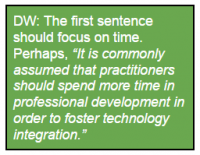Sharing recent feedback I received with a peer, I laughed when he asked, “Is that a new font–Strike through?” One entire page had that font. Fortunately for me, this wasn’t the only feedback or I may have felt like a huge strike out. Instead, thanks to my advisor following the three guidelines of giving effective feedback, I felt excited to take his advice. Here is what he did:
 1. Started with a positive affirmation of my effort and how I’m doing related to the big picture of the assignment.
1. Started with a positive affirmation of my effort and how I’m doing related to the big picture of the assignment.
2. Inserted straightforward advice throughout my writing on what worked and what did not.
3. Gave me specific recommendations for next steps I could take to get to the next level, including sending a successful example for me to compare.
In my experience as a teacher and a learner, many people give and receive feedback with the first two guidelines covered. Yet, that third guideline is often most helpful to lifelong learning, or the learning how to learn Significant Learning Outcome. After all, if we knew how to fix our mistakes, most of us would choose not to make them–especially in front of others! Guideline number three has a few areas to be careful of to prevent sending students chasing a foul ball instead of a home run, however.
 First, specific recommendations are more useful than generalities.
First, specific recommendations are more useful than generalities.
Second, the next steps are for me as the learner to take (or not). No one can learn for someone else.
Third, he didn’t directly compare my work to someone else’–he sent an example for my self-assessment. Reading how the other person navigated similar challenges helped me see where my work went astray.
As an instructor, this type of feedback may feel overwhelming to give when facing grading deadlines for multiple classes. Fortunately, there are ways using Moodle and other technologies can help accomplish this. For example, Moodle allows instructors to upload a file folder of successful examples of assignments for students to compare. Or, instructors can link to their Google Drive or other web resources with solid examples to follow. PoodLL lets instructors give audio feedback right inside of their course shell.
Jing (free screencasting program) and Ensemble (NMC’s video repository) are two tools to add a personal touch to feedback for large groups. In Jing, instructors can record audio describing work visible on the screen–a “play by play” of what works and what doesn’t. Ensemble can host any video example or explanation, with the added benefit of being able to annotate where different types of challenges were addressed. Some instructors use this with mini-lectures on hard to understand concepts, allowing the student to scan the list of annotations and see where they need to review.
Want to know more? Contact the Ed Tech Department at 231-995-1070 or put in a Help Desk ticket with your questions. Or, use the tag cloud on this site to read ideas from other faculty members.
SmartBrief on Leadership also recently posted a blog: What Makes Performance Feedback Useful
A special thanks to Dr. David Wong, my MSU advisor, for all that you do to keep me on the right path.

